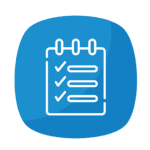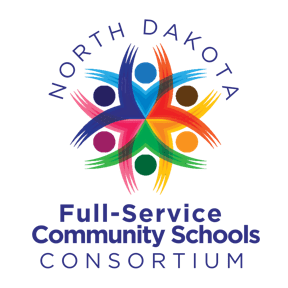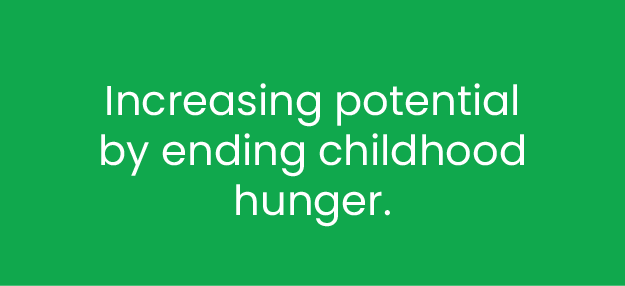QUICK FACTS
Service: Backpack Program and School Pantry Program
Pipeline Service Area: Wellness – Nutrition
Provider: Great Plains Food Bank
Contact Information:
Jenae Meske, Child and Senior Hunger Program Manager
jmeske@greatplainsfoodbank.org
What it is:
The Great Plains Food Bank’s mission is to end hunger, together. Through initiatives like the Backpack Program and School Pantry Program, Great Plains is working to create a world in which every student comes to school fed, healthy, and ready to learn.
HOW IT WORKS
Food insecurity can have lifelong physical, emotional, and developmental consequences for children. In the classroom, hungry children have been proven to experience difficulty focusing, which limits their ability to reach their full potential.
Great Plains Food Bank believes that when a child is fed, they are equipped to learn, grow, and imagine a future filled with opportunity.
“In order for a child to be able to learn and to absorb information, they need to be fed,” said Jenae Meske, Great Plains Child and Senior Hunger Program Manager. “Being able to either slip a bag of food into a child’s backpack or let the family come into the school to get food takes a huge burden off of them.”
More than 33,000 children across North Dakota qualify for and rely on the federal free and reduced lunch program to meet their daily nutritional needs. But on weekends, many of these children go hungry.
The Great Plains Food Bank Backpack Program was created in 2010 to keep kids fed from Friday afternoon through Monday morning. Great Plains fills bags with roughly three pounds of shelf-stable food, including breakfast items, lunch items, snacks, and drinks. The bags are then delivered to schools, where they are placed in students’ backpacks.
Identifying families who could benefit from the Backpack Program works differently for every school. Some send out letters to the parents of students who receive free and reduced lunch, allowing them to opt into the program. Others utilize a referral program to keep an eye out for students who may be experiencing food insecurity.
“We have these programs in Head Start all the way up to high school, so we are able to mold it and fit it as we need to to fit those different school types,” Meske said.
Whereas the Backpack Program focuses on the food insecurity of one specific student, the Great Plains School Pantry Program addresses the needs of the entire family. Launched in 2015, this program allows schools to create a miniature food pantry within the walls of their building.
Pantry items are either purchased in bulk by Great Plains or donated to the food bank by local grocery stores. Participating schools can then purchase food from Great Plains at a significantly lower cost than at any grocery store.
“We know that a lot of teachers spend their own money on their students and their families,” Meske said. “Being able to take that burden off of the teachers and allow a program like this to grow and evolve and be what it needs to be for each school is amazing.”
The food pantry can be accessed either by individual students, who can pack up a box of food for their family, or by their parents. Items from these pantries are available at no cost, reducing the financial burden of feeding families. In addition to cost, the School Pantry Program also eliminates barriers such as time and transportation.
“Many of these communities have food pantries and soup kitchens, but their hours are not always ideal for working parents with children in school,” Meske said. “Having a pantry in the building allows schools to have a better relationship with their families and determine if there are other resources they can connect them with.”
Like the Backpack Program, the School Pantry Program has been created with flexibility in mind. Schools can choose to stock different items–such as frozen foods, clothing, or personal care items–based on the needs of their students and the facilities at their disposal.
“If you have a school that doesn’t have a lot of room, we are able to make something work,” Meske said. “We had one school in particular that started with a locked cabinet in a hallway, and then they graduated to an entire basement.”
Great Plains has not just created a program; they have created a community. There are approximately 75 Backpack Programs and 35 School Pantry Programs currently active across the state. Schools are encouraged to connect with each other and the food bank to share their experiences and insight–because when schools work together, students win.
“We have a program in almost every single inch of this state. We can provide examples of how this program works in elementary schools and high schools, in small towns and big communities like Fargo,” Meske said. “By working with us, schools don’t have to reinvent the wheel to create their own programs. They can spend that time to helping students learn.”
HOW TO DO IT
Schools interested in becoming an ND Reading Corps host site are encouraged to submit an application at www.ndreadingcorps.org. If you have any questions, please contact:
Jenae Meske, Child and Senior Hunger Program Manager
jmeske@greatplainsfoodbank.org

WHO WE ARE
We are a Consortium representing a variety of ND schools and organizations who are passionate about helping ND students and families succeed.

WHAT WE DO
We partner with local leaders to coordinate comprehensive supports in areas such as wellness , workforce readiness, and academic enrichment to help students, families, and communities thrive.




